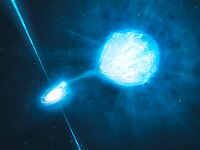
Photo from wikipedia
With its last observing run, the LIGO, Virgo, and KAGRA collaboration has detected almost one hundred gravitational waves from compact binary coalescences. A common approach to studying the population properties… Click to show full abstract
With its last observing run, the LIGO, Virgo, and KAGRA collaboration has detected almost one hundred gravitational waves from compact binary coalescences. A common approach to studying the population properties of the observed binaries is to use phenomenological models to describe the spin, mass, and redshift distributions. More recently, with the aim of providing a clearer link to astrophysical processes forming the observed compact binaries coalescences, several authors have proposed to employ synthetic catalogs for population studies. In this paper, we review how to employ and interpret synthetic binary catalogs for gravitational-wave progenitors studies. We describe how to build multi-channel merger rates and describe their associated probabilities focusing on stellar progenitor properties. We introduce a method to quantify the match between the phenomenological reconstruction of merger rates with synthetic catalogs. We detail the implementation of synthetic catalogs for multi-channel hierarchical Bayesian inference, highlighting computational aspects and issues related to hyper-prior choice. We find that when inferring stellar progenitors’ properties from gravitational-wave observations, the relative efficiency in compact objects production should be taken into account. Finally, by simulating binary black hole detections with LIGO and Virgo sensitivity expected for the O4 observing run, we present two case studies related to the inference of the common envelope efficiency and progenitor metallicity of the binary black holes. We finally discuss how progenitors’ properties can be linked to binary black hole properties.
Journal Title: Monthly Notices of the Royal Astronomical Society
Year Published: 2022
Link to full text (if available)
Share on Social Media: Sign Up to like & get
recommendations!